
The purpose of this file is to collect images that show the distinctive buckle motif, and, eventually, to discover the manufacturers of the patterns that used this motif. Although the examples in this file are limited to images that have never been published, references to published images are also included. Thus, the reader can make detailed comparisons of various versions of the so-called "Buckle" pattern.
Perhaps the earliest example of the "Buckle" pattern is the one that appears on a wine-glass cooler at the Wadsworth Atheneum (acc. no. 1956.3534), where it has been given an early date of c1820-30 and an Irish origin (Warren 1981, illus. 204). A more recent example of the pattern is on a wine glass by T. G. Hawkes & Company at the Corning Museum of Glass (acc. no. 92.4.26). Spillman (1996, p. 182) suggests a date of c1910-20 for this glass. Thus, we have a period of about one hundred years during which the "Buckle" pattern was produced. These examples, together with the tableware in this file, have patterns that are essentially identical. Spillman (1996, p. 201) also indicates that
The "Buckle" pattern, which was originally cut in the 1850s when it seems to have been popular in pressed glass, was made by a number of firms, Dorflinger among them, but several pieces are known with Hawkes signatures.Concerning this quote, note the following: (i) Spillman's date of the 1850s undoubtedly refers to the American production of the "Buckle" pattern because we have the evidence, cited above, that the pattern was in production in Ireland during the 1820s. (ii) The Hawkes signatures, which consist of block letters, indicate that items in this pattern were being made in Corning after c1910. They may be survivors from a special order, or from a catalog order made from an unknown Hawkes catalog. (iii) The Dorflinger attribution is questionable because reliable evidence is lacking. The attribution may, at least in part, be the result of an incorrect interpretation of the so-called "Brooklyn star" (actually, a flashed star), a motif that is usually (always?) associated with the "Buckle" pattern, but not exclusively, and not limited to items made by Dorflinger. These points are discussed further in this file following descriptions of two examples of the pattern as found on stemware and finger bowls.
Goblet cut in the "Buckle" pattern. Its foot is cut with an 8-pt star that is flashed with 5-ribbed fans. c1870. H = 6.75" (17.1 cm). Sold for $100 in 1990. It and a companion, together with a pair of matching wine glasses, were purchased at an auction in Otego, NY in 1990. The wine glasses (clarets?) also have 8-pt starred feet but they are flashed with 4-ribbed fans. Their dimensions: H = 5.5" (14.0 cm), rim D = 3" (7.6 cm). The pair of wines sold for $25 in 1990: one glass has a rim chip, while the other has a poor-quality repair on the rim of its foot.

The following pair of finger bowls are cut in a "Buckle" pattern that matches that of the goblet. The bowls have nine "buckles", the tenth "buckle" on each bowl having been replaced with an engraved monogram, also shown below. The monogram is barely visible in this image, the only one that is available. According to the seller of the finger bowls the surface of this "buckle" is flat; it has no indentation. The monogram is on a shield, above which is a semi-ellipse of strawberry (fine) diamonds. The seller also reports that the finger bowls were purchased from an estate and that one of them contained a piece of paper with the information that "the bowls are 'Hopleius' or 'Hapleius' Crystal in the Bubble Pattern and [are] early Dorflinger pieces." The writer has not been able to find any reference to "Hopleius" or "Hapleius" cut glass. Does the reader have a suggestion?
Pair of finger bowls in the "Buckle" pattern, c1870. H = 3" (7.6 cm), rim D = 4.25" (10.8 cm). Sold for $40 at an eBay auction in 2004.


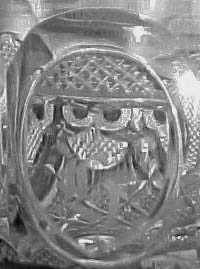
Each finger bowl has an integral, shallow foot and an overall shape common to finger bowls of the mid-nineteenth century. The feet are cut with 8-pt stars flashed with 5-ribbed fans. D of foot = 2.5" (6.4 cm), H of foot = 0.25" (0.6 cm).

Concerning the three points mentioned previously:
(i) All examples of the "Buckle" pattern that the writer has seen to date share the following unusual characteristic: The buckles are outlined by the use of slice cutting, not miter cutting. (See the cutting2.htm file in Part 1 for an explanation of this type of cutting.) Slice cutting surrounds each buckle with a broad, shallow, sloping surface that causes the buckle -- which is more properly called a boss at this point -- to be raised above the cut surface. The boss's surface is then completely cut with strawberry (fine) diamonds. Bosses made in this manner are shown on an octagonal decanter that is believed to have been made in Cork, c1830. It is pictured in Westropp's classic book on Irish glass (Westropp 1978, p. 76).
To change the boss into a "buckle" one needs only to cut an elongated bullseye in the center of the boss. This overcutting produces a reducing lens that lends additional interest to the pattern. The similarity of this motif to an old-fashioned belt buckle is probably a coincidence and not the result of a conscious decision on the part of the designer/cutter. However, collectors have relied on this similarity for decades, except for the few who think of the buckles as bubbles!
(ii) Rather than devote an entire "buckle" to a monogram-shield, Hawkes cut the elongated bullseyes wide enough to accomodate a single, engraved letter. Thus, the stemware could be sold with, or without, a monogram without the necessity of having to maintain two inventories: one set of stemware with a monogram-shield plus "buckles", the other set cut entirely with "buckles". This assumes, of course, that a monogrammed nineteenth century drinking glass uses the same monogram-shield that that has been found on finger bowls and covered butter dishes. If this assumption is correct, then the Hawkes wine glass (Spillman 1996, p. 182) probably is not a replacement for a broken nineteenth century glass -- as might be supposed -- but is more likely to have come from either a special order or an order from an as-yet undiscovered Hawkes catalog.
(iii) The writer, to date, has been unable to find any reliable evidence that the "Buckle" pattern was cut by any factory run by Christian Dorflinger -- neither at White Mills nor earlier, in Brooklyn -- which is contrary to popular belief. This unexpected situation is supported, however, by the following points which acknowledge, as background, the disasterous fire of 1892. This event destroyed "all of the designs and patterns for fine cut glasswork" according to Suydam (c1950, p. 33)(note 1).
(1) There is no mention of the "Buckle" pattern in Feller's comprehensive study of the Dorflinger companies and their products, nor is the pattern illustrated (Feller 1989).
(2) The pattern does not appear in the ACGA's composite catalog of patterns, some of which pre-date the fire.
(3) Numerous articles about C. Dorflinger & Sons, including the authoritative series by Katheryn H. D. Manchee (The Magazine Antiques, 1972), fail to mention the pattern or to provide any illustration that could represent it.
Because our subject is cut glass, we should expect an exception to the foregoing. Here it is:
A fine covered butter dish in the "Buckle" pattern is illustrated in the book THE GLASS INDUSTRY IN WAYNE COUNTY, PENNSYLVANIA by Barbe and Reed (2003, p. 67). It is, however, accompanied by not one word of documentation. The dish is merely grouped on a page with authentic Dorflinger pieces and described as "Butter dish in early 'Buckel' (sic) pattern." The dish's cover includes the same monogram-shield that is found on the finger bowls. Because this image is of higher quality than that example, one can actually see the outline of the shield. Nevertheless, the monogram itself can not be deciphered. It is said to be the letter M (see note 2 for details). Considering the importance of the butter dish, the authors' reticence is difficult to understand. We are not even told where it can be found today! (The dish is currently in a private collection.)
In summary, available evidence indicates that the covered butter dish might have been made by Dorflinger, but it is equally likely to have been made by some other manufacturer. The material on hand today is inadequate to form a conclusion (note 3). Some day, however, it will undoubtedly be possible to name the manufacturer(s) of the "Buckle" pattern, but to do so will require additional evidence, evidence that avoids fanciful comparisons and wishful thinking.
Compote, attributed to the Dorflinger Glass Company, c1865. H = 8.75" (21.5 cm), rim D = 8.25" (21.0 cm), foot D = 5.25" (13.3 cm), wt = 4.5 Lb (2.0 kg). Sold for $160 at an eBay auction in 2004.
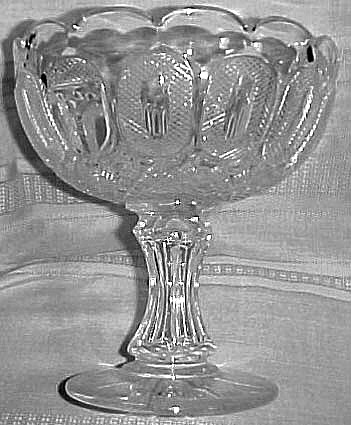
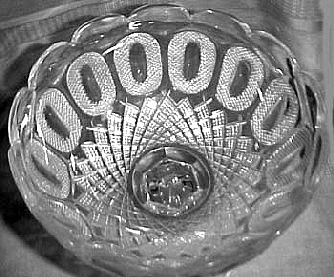
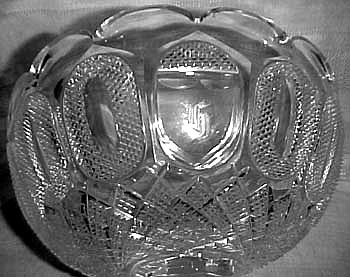

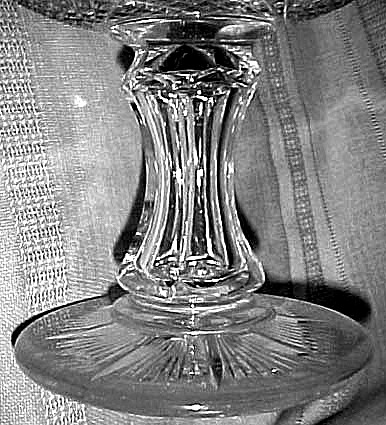
NOTES:
1. This is probably an overstatement because investigators have been able, over the years, to re-construct lists of products produced by Dorflinger prior to the fire. They are probably incomplete, however. Some patterns are undoubtedly lost forever; "Buckle" could be one of them.
2. In 1999 the writer was sent two catalogs that list Dorflinger items that were displayed at the annual convention of the American Cut Glass Association which was held that year in Philadelphia. The butter dish was one of the items on display, and the catalog contains the following information:
Made at Long Island Flint Glass Works in the mid 1850's. Dorflinger Guards item "look-a-like" with the monogram "M". Brooklyn star bottom and Buckle Pattern and Strawberry Diamond (from "Stories about the Dorflinger Glass" by the Dorflinger Exhibit Committee, p. 5).For the record, the motif listed as "strawberry diamond" should be "English strawberry diamonds", the motif that shares top-billing with the buckle motif on the butter dish. But there is another, more serious problem: The catalog entry compares the dish to the famous Dorflinger Guards vase that was presented to Mrs. Dorflinger in 1859, describing it as a "look-a-like". An excellent photograph of this 17" (43.2 cm) tall vase can be found in Feller (1989, p. 187). Comparison of the patterns on the two items reveals no "look-a-like". In fact, one is struck by several major differences between the two items. Yet, it is likely that the designer of the vase was familiar with the "Buckle" pattern -- a pattern found on both cut and pressed glass and one that was popular at the time -- because he mimicked the "buckle" motif. He did this by using a pair of curved miter cuts to form a vesica, in place of the continuous, slice-cut ovals that are found in the "Buckle" pattern and which define it. This difference is especially significant. Additional differences are these: The pattern on the vase has fans, while there are none on the butter dish; the vase lacks the English strawberry diamonds that are a prominent feature of the "Buckle" pattern; and the pattern on the vase's foot echos that on its body -- the foot is not cut with a flashed star, the so-called Brooklyn star, that appears on the butter dish's underplate (but which is no indication of a particular manufacturer).Dimensions: D = 8.75" (22.2 cm), H = 6" (15.2 cm).
3. As of 26 May 2004 several wine glasses in the "Buckle" pattern are reported to be at the Dorflinger Glass Museum; they are on loan from a private collection. In addition, two "Buckle" decanters were seen several years ago by the museum's curator. It is believed that both are now in a private collection.
Updated 25 Apr 2005